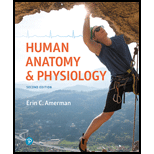
Concept explainers
Which of the following is not a basic function shared by all cells?
a. Cell
b. Communication
c. Cell reproduction
d. Cell movement
e. Transport of substances through the cell
Introduction:
In a living organism, the basic units are cells. Based on the estimation, there are almost 10 trillion cells in a human body that work together to regulate homeostasis. Being the basic unit, the cells form a group, which can perform a specific role in the human body. The functions performed by the cells differ based on the group of cells.
Answer to Problem 1CYR
Correct answer:
Cell movement is not the basic function.
Explanation of Solution
Justification/Explanation for the correct answer:
Option (d) is cell movement. This is not a basic function of the cell. Cell movement is also called cell migration. Cell migration often results in the altering of cell morphology. Cell movement is often associated with microorganismsthat have cilia and flagella as their locomotory appendage. Not all cells can exhibit movement. Hence, option (d) is correct.
Explanation for the incorrect answers:
Option (a) is cell metabolism. Cell metabolism is a basic function of the cells. To maintain life, a cell must undergo various chemical reactions. These chemical reactions are called cell metabolism. Catabolism, anabolism, and oxidation–reduction reactions are various types of cell metabolism. So, it is an incorrect option.
Option (b) is communication. Cell communication is an important function of the cells. Not only the cell has to communicate with itself, but it also has to communicate with its surrounding. The communication within the cell and with its surrounding occur bymeans of electrical and chemical stimuli. So, it is an incorrect option.
Option (c) is cell reproduction. The cell reproduction is the basic function performed by the cell in a living system. The cells undergo cell division, which is the means of cell reproduction in the living organism. Cell division aids in development, growth, and regeneration. So, it is an incorrect option.
Option (e) is transport of a substance through the cell. The cells in our body are capable of producing compounds and transport them to the surrounding environment. Cells can also secrete the compound themselves and transport it to other cells. This is the basic function of z cell. So, it is an incorrect option.
Hence, options (a), (b), (c), and (e) are incorrect.
Hence, it can be concluded that cell movement is not the basic function. Even though some cells exhibit migration, not all the cells are capable of cell movement. Cell metabolism, communication, cell reproduction, and transport of a substance through the cells are the basic functions performed by the cell.
Want to see more full solutions like this?
Chapter 3 Solutions
Pearson eText Human Anatomy & Physiology -- Instant Access (Pearson+)
- Noggin mutation: The mouse, one of the phenotypic consequences of Noggin mutationis mispatterning of the spinal cord, in the posterior region of the mouse embryo, suchthat in the hindlimb region the more ventral fates are lost, and the dorsal Pax3 domain isexpanded. (this experiment is not in the lectures).a. Hypothesis for why: What would be your hypothesis for why the ventral fatesare lost and dorsal fates expanded? Include in your answer the words notochord,BMP, SHH and either (or both of) surface ectoderm or lateral plate mesodermarrow_forwardNot part of a graded assignment, from a past midtermarrow_forwardNot part of a graded assignment, from a past midtermarrow_forward
- please helparrow_forwardWhat does the heavy dark line along collecting duct tell us about water reabsorption in this individual at this time? What does the heavy dark line along collecting duct tell us about ADH secretion in this individual at this time?arrow_forwardBiology grade 10 study guidearrow_forward
 Human Biology (MindTap Course List)BiologyISBN:9781305112100Author:Cecie Starr, Beverly McMillanPublisher:Cengage Learning
Human Biology (MindTap Course List)BiologyISBN:9781305112100Author:Cecie Starr, Beverly McMillanPublisher:Cengage Learning Concepts of BiologyBiologyISBN:9781938168116Author:Samantha Fowler, Rebecca Roush, James WisePublisher:OpenStax College
Concepts of BiologyBiologyISBN:9781938168116Author:Samantha Fowler, Rebecca Roush, James WisePublisher:OpenStax College Biology 2eBiologyISBN:9781947172517Author:Matthew Douglas, Jung Choi, Mary Ann ClarkPublisher:OpenStax
Biology 2eBiologyISBN:9781947172517Author:Matthew Douglas, Jung Choi, Mary Ann ClarkPublisher:OpenStax





